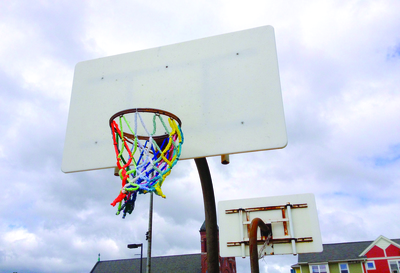LIVING AS FORM (THE NOMADIC VERSION)
In 2011, Creative Time’s groundbreaking exhibition, Living as Form, came to New York’s Essex Street Market. The exhibition featured works created from 1991–2011 that examined the interstices between art, everyday life, and social practice. Nato Thompson, curator of Living as Form, selected 48 socially engaged projects as the foundation for further iterations of this exhibition. Traveling across the world on a hard drive, Living as Form (The Nomadic Version) accumulates work as it goes, increasing the diversity of practices shown. Partnering with Independent Curators International (ICI), participating venues choose local artists to show alongside a selection from Thompson’s initial 48.

Maria Molteni and New Craft Artists in Action, Finger Knit Net Work, 2013, made in collaboration with Cushing House Men’s Group, South Boston. Photo: Maria Molteni.
Living as Form (The Nomadic Version) is currently on view at The Carpenter Center for the Visual Arts. Guest curator Claire Grace has prioritized works that take a sharp lens to various political issues while maintaining a commitment to representing emerging artists with ties to Boston and Providence.
Much of the work in the exhibition reflects strategies for accessing and challenging designations of space. In Studio, 1991, artists Farid Jahangir, Sassan Nassiri, Bita Fayyazi, Att Hasheminejad, and Khosrow Hassanzedeh reclaim an abandoned home in Tehran as a collaborative studio space. In Athi-Patra Ruga’s Miss Congo, 2007, Ruga spends one year weaving tapestries in public spaces as Miss Congo, a character developed in response to racial and gender inequalities witnessed in Senegal. Networks, begun in 2010 by Boston’s Maria Molteni and New Craft Artists in Action, playfully reclaims space by creating handmade nets for abandoned hoops in public basketball courts. The Los Angeles Poverty Department examines notions of access in Agents & Assets, 2001 and ongoing, by hiring homeless actors to perform as legal officials. Young citizens are empowered by assuming roles off-limits to them in Caitlin Berrigan’s Lessons in Capitalism, 2014, where children are enlisted as financial advisors.
Connectivity is at the essence of Living as Form (The Nomadic Version) and the CCVA has programmed several free public events in tandem with the exhibition. Featuring 32 diverse works and a substantial participatory element, the exhibition promises to inspire critical creative thought around socially engaged practices on a global level, simultaneously acting locally by addressing issues pertinent to New England.
